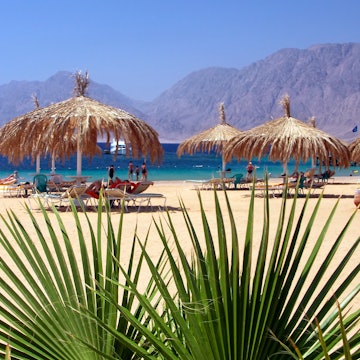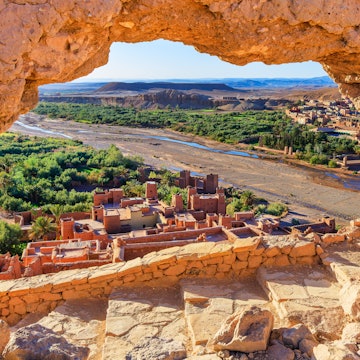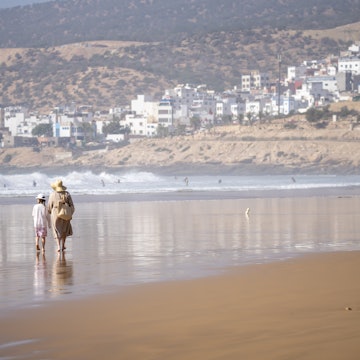

A spice market near Khan Al Khalili in Cairo, Egypt. John Wreford/Shutterstock
Cairo is a boon for travelers on a budget. Many of the city’s sights are free or inexpensive to visit; paying just 540 Egyptian pounds (LE) gets you entry to the Pyramids of Giza, for example.
While the biggest attractions in Greater Cairo – the Pyramids, the Egyptian Museum, the Grand Egyptian Museum and the National Museum of Egyptian Civilization – do charge entry fees, they are nominal compared with museums in Europe and North America. All costs add up, however, so supplement your itinerary with any of these amazing free things to do in Cairo.

1. Understand Islam at Al Azhar Mosque
One of the most important religious buildings in Egypt, Al Azhar Mosque was constructed in Cairo’s infancy, around 970 CE, making it among the oldest mosques in the city. About two decades later, a madrasa was added. It grew into a university (the second-oldest institution of higher learning in the world, after the Kairaouine in Fez, Morocco), and it still accepts students studying Sunni theology and Islamic law.
Successive waves of empires and rulers left their stamp on Al Azhar, adding, building and rebuilding various elements of the mosque. Visitors first encounter a large, gleaming white marble courtyard surrounded by minarets from the 14th to 16th centuries and arches with inscriptions. Keep an eye out for what’s thought to be the original mihrab (a niche indicating the direction of Mecca), with marble columns and gold-colored inscriptions curling up around the semidome.
Planning tip: All travelers are required to dress appropriately when visiting mosques in Egypt, but the rules at the free Al Azhar are stricter than others, perhaps because of its elevated status. If the attendants at the door deem you improperly dressed (and for foreign female travlers, that’s almost always the case no matter what you’re wearing), you’ll be loaned a cover-up to wear during your visit.

2. Browse the stalls at Khan Al Khalili
Weave your way under ornate arches and along labyrinthine lanes through the medieval market of Khan Al Khalili. It might be difficult to keep your wallet in your pocket as you admire all the goods – clothing, toy camels, scarves, perfumes, spices, shisha pipes, metal lanterns and standard souvenirs – and the smooth-talking shopkeepers will certainly promise you that you can look for free.
Planning tip: Rest your legs at Fishawi’s, possibly Cairo’s oldest ahwa (coffeehouse), which opened in the 18th century. Sip a Turkish coffee or mint tea among the dark wood interiors, hazy mirrors and copper-top tables that harken back to a bygone era. Some of Khan Al Khalili’s most persistent sellers will even come to the shop to find you.

3. Get to know Egypt’s indigenous religion in Coptic Cairo
Although Egypt is now a Muslim-majority country, it’s home to the largest Christian community in the Middle East, the Copts, who have practiced their religion here since antiquity. Set within the walls of an ancient Roman fortress, the neighborhood of Coptic Cairo has a wonderful clutch of churches and monasteries that show a different side of the country’s religious culture. The pedestrianized interior makes for a pleasant stroll.
The free Hanging Church, so named because it was built over the southern gate of the fortress, is ornately decorated with a wooden barrel-vaulted roof, marble pillars and geometric inlays. The church has more than 100 icons, including the 8th-century “Coptic Mona Lisa,” which shows the Virgin Mary, Jesus and John the Baptist. Other ornate and impressive churches within the complex that are free to visit include the Church of St George, the Church of St Sergius and Bacchus and the Church of St Barbara.
Just outside the Coptic compound, the oldest synagogue in Cairo, Ben Ezra Synagogue, was once a Coptic church. For LE40 and lots of insight, visit the Coptic Museum to admire more than 1000 pieces of Coptic art on view, from textiles to frescoes.
Planning tip: The Mar Girgis Cairo Metro station is right in front of the complex, and a ticket costs just 5–12LE depending on how many stations you travel through. Avoid visiting from Friday to Sunday when services, weddings and an influx of domestic tourists make the area busier.

4. Count Cairo's thousand minarets from the Mosque of Ibn Tulun
The dusty, desert-hued 9th-century Mosque of Ibn Tulun might look like one of Cairo’s plainer mosques at first glance, but the geometry of the structure, particularly when seen from the top of the minaret, is striking. Stepped crenellations stand guard on top of the walls. The mosque’s namesake was sent by the Abbasid caliph in Baghdad to rule over the outpost of Fustat, and the spiral minaret is modeled after the Mosque of Samarra in Iraq. From this free outlook, you can see why Cairo is called the City of a Thousand Minarets.
5. Admire art in Cairo’s contemporary galleries
Even if you’ve never been to the country, the art of the ancient Egyptians is instantly recognizable, and Egypt’s art tradition carries on today. The neighborhood of Zamalek, on the northern tip of an island in the Nile, has a particularly dense concentration of art galleries, including the Zamalek Art Gallery, Picasso Art Gallery and Al Masar Gallery. Nearby, the gorgeous interiors of Aisha Fahmy Palace, with frescoed walls and stained glass windows, also form a beautiful backdrop for art exhibitions.

6. See another side of the city in Manshiyet Nasr
Nicknamed Garbage City, Manshiyet Nasr is the home of a Coptic Christian community called Zaraeeb (or derogatorily as Zabbaleen, meaning “Garbage People”). Residents here collect trash from households around Cairo, then sort and recycle it, and their recycling methods have been recognized as among the most efficient in the world.
Built into a cave on the ridge of the Muqattam Hills, the Church of St Simeon the Tanner (also called the Cave Church) is an impressive site. Seats for some 17,000 worshippers cascade from the mouth of the cave down to a central altar like an amphitheater.
This neighborhood also displays a huge mural called Perception, by French-Tunisian artist eL Seed, known for his “calligraffiti” style that blends calligraphy with street art. Perception spans 50 buildings but can be seen in full from only one viewpoint. The script is a quote from St Athanasius, a 3rd-century Coptic bishop in Alexandria, and reads, “Anyone who wants to see the sunlight clearly needs to wipe his eyes first.”
Planning tip: While the church and mural are free to visit, consider hiring the services of a local guide, who can help you navigate to the viewpoint for seeing the artwork (it’s difficult to find) and facilitate conversations with residents.
















